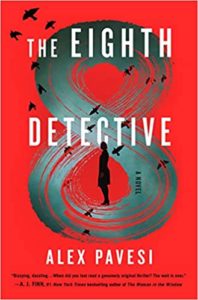 While Alex Pavesi’s concept in The Eighth Detective isn’t entirely new, it’s still entirely welcome and ingenious. John Dickson Carr, in his novel The Three Coffins (1935), presented a locked room mystery while at the same time breaking away to analyze and discuss the mechanics of detective fiction to his readers. Carr’s hero, Dr. Gideon Fell, takes on the job of explaining the different plot variations. Pavesi has taken it a step further even than the ingenious Carr, however.
While Alex Pavesi’s concept in The Eighth Detective isn’t entirely new, it’s still entirely welcome and ingenious. John Dickson Carr, in his novel The Three Coffins (1935), presented a locked room mystery while at the same time breaking away to analyze and discuss the mechanics of detective fiction to his readers. Carr’s hero, Dr. Gideon Fell, takes on the job of explaining the different plot variations. Pavesi has taken it a step further even than the ingenious Carr, however.
Pavesi’s central character in the novel, Grant McCallister, lives a hermit’s life on a remote island. Twenty years ago, he’d written a book called The White Murders, published in the early 1940’s. The book in our hands is a series of short murder mystery stories, interspersed with McCallister’s mathematical analysis of the murder mystery. There are a certain number of required elements and within this structure – and, as mystery readers everywhere already know – there are endless variations.
McCallister is being visited by an editor, Julia Hart, whose publisher is interested in reprinting The White Murders. To that end, she reads aloud each short mystery, and then she and Grant discuss the stories, including whatever slight discrepancies there might be in each one.
After each story, a new element of detective fiction is discussed: suspects, a detective, a killer or killers. How these elements intersect provides the various, as McAllister calls them, permutations of detective fiction. Each story provides a different example, some very clearly based on Agatha Christie’s novels. Because Christie was responsible for creating many of the tropes of detective fiction – most famously: everyone is the killer, the narrator is the killer, and everyone is killed – these are some of the tropes chosen by Pavesi in his clever, bitter little stories.
As the book progresses, Julia also quizzes Grant about himself – why does he live alone on a remote island? Why has he never written anything else? Why does he have such a hazy memory of stories he, after all, has written, even if twenty years ago?
There are so many calls and references to other mysteries within the pages of this book that to truly appreciate it I think you almost have to be a lifelong, hardcore lover of the genre. (The setting and time period made me think of Mary Stewart’s romantic 1962 novel The Moonspinners). The stories, however, are vivid in and of themselves.
And the clever story within a story, Julia’s editing and questioning of Grant himself, creates yet another permutation of the book. Some of the stories are stronger than others. My personal favorite was the one based on Christie’s And Then There Were None (1939). Pavesi takes it one further by having a family close enough to the death island to wonder what’s happening there, enough to make them go and investigate. He creates observers for us, as readers, to observe.
Because the book sets itself smack in the middle of the golden age of detective fiction – a time when Christie, Sayers and others were writing – and then self consciously looks back at the 40’s not from the present but instead from the late 1960’s, the perceptions then are filtered once again by our own in the present day. Pavesi is placing us at one remove from the pleasure of pure narrative storytelling and inviting us, instead, to consider and analyze detective fiction. I think his ultimate question is, what makes detective fiction so enjoyable?
The book asks the reader if the detective novel has worn itself out. I think we can answer a resounding “no”, as long as books as clever and memorable as this one continue to be written. The permutations of suspects, detective and killer continue to fascinate us, as do the resolution and answers provided by the mystery novel. The Eighth Detective does not disappoint, as it presents these elements as well as providing the reader with a more than delicious resolution. This is the kind of book you may want to read again the minute you finish it.